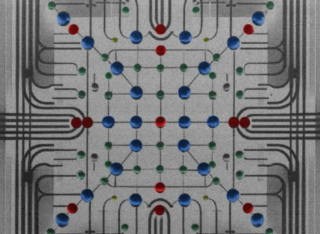
Veronika Zelyk
About
My research project
Nano-scale 3D printing for rapid quantum device constructionThis project involves the development of new “direct-write” methods for nanoscale construction of silicon single-electron transistors (Si-SET) using focused ion and electron beams.
Supervisors
This project involves the development of new “direct-write” methods for nanoscale construction of silicon single-electron transistors (Si-SET) using focused ion and electron beams.
Publications
Single impurities in insulators are now often used for quantum sensors and single photon sources, while nanoscale semiconductor doping features are being constructed for electrical contacts in quantum technology devices, implying that new methods for sensitive, non-destructive imaging of single- or few-atom structures are needed. X-ray fluorescence (XRF) can provide nanoscale imaging with chemical specificity, and features comprising as few as 100 000 atoms have been detected without any need for specialized or destructive sample preparation. Presently, the ultimate limits of sensitivity of XRF are unknown - here, gallium dopants in silicon are investigated using a high brilliance, synchrotron source collimated to a small spot. It is demonstrated that with a single-pixel integration time of 1 s, the sensitivity is sufficient to identify a single isolated feature of only 3000 Ga impurities (a mass of just 350 zg). With increased integration (25 s), 650 impurities can be detected. The results are quantified using a calibration sample consisting of precisely controlled numbers of implanted atoms in nanometer-sized structures. The results show that such features can now be mapped quantitatively when calibration samples are used, and suggest that, in the near future, planned upgrades to XRF facilities might achieve single-atom sensitivity.
We report X-ray fluorescence (XRF) imaging of nanoscale inclusions of impurities for quantum technology. A very bright diffraction-limited focus of the X-ray beam produces very high sensitivity and resolution. We investigated gallium (Ga) dopants in silicon (Si) produced by a focused ion beam (FIB). These dopants might provide 3/2-spin qubits or p-type electrical contacts and quantum dots. We find that the ion beam spot is somewhat larger than expected, and the technique provides a useful calibration for the resolution of FIBs. Enticingly, we demonstrate that with a single shot detection of 1 second integration time, the sensitivity of the XRF would be sufficient to find amongst background a single isolated inclusion of unknown location comprising only 3000 Ga impurities (a mass of just 350 zg) without any need for specialized nm-thickness lamellae, and down from >105 atoms in previous reports of similar work. With increased integration we were able to detect 650 impurities. The results show that planned facility upgrades might achieve single atom sensitivity with a generally applicable, non-destructive technique in the near future.
